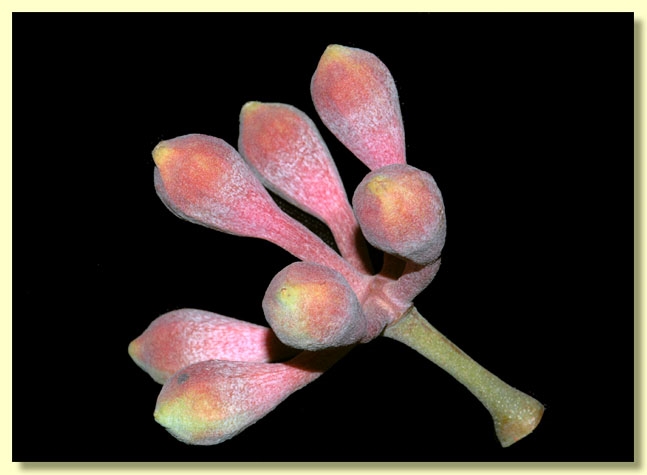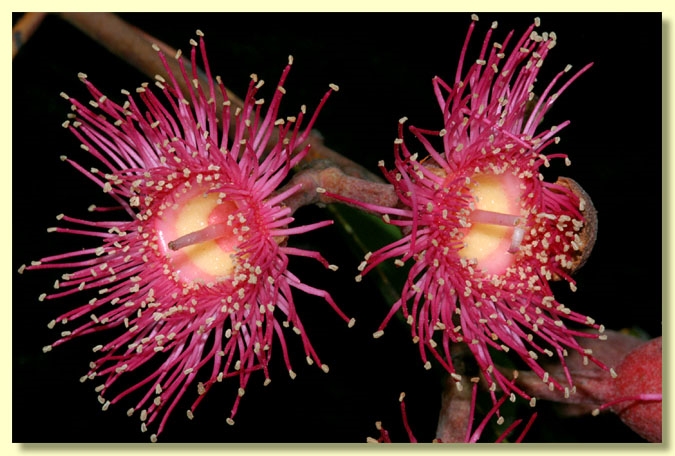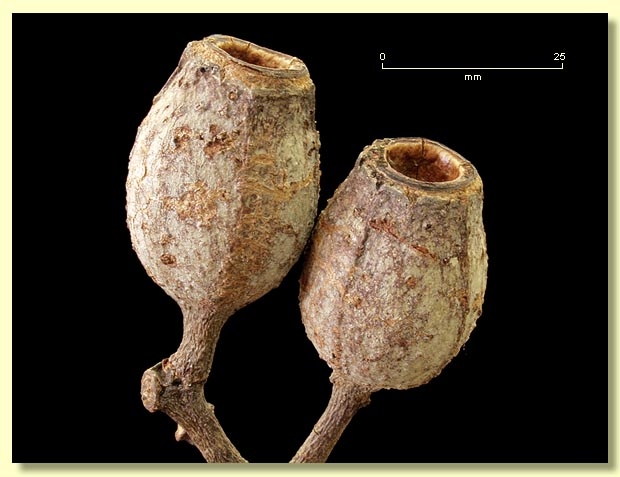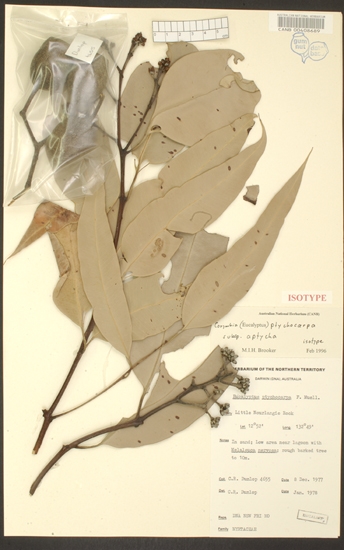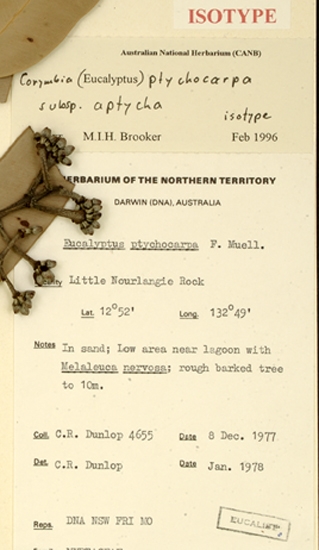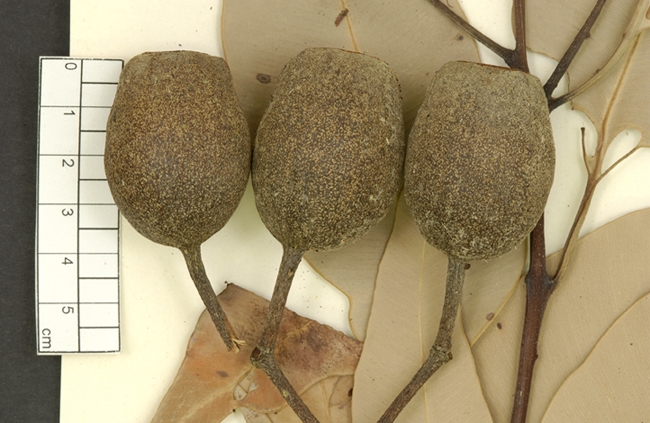Euclid - Online edition
Corymbia ptychocarpa subsp. aptycha
Corymbia | Rufaria
Corymbia ptychocarpa subsp. aptycha K.D.Hill & L.A.S.Johnson, Telopea 6: 251 (1995).
Tree to 15 m tall. Forming a lignotuber and rhizomes.
Bark rough to the small branches, thick, fibrous and fissured to tessellated, brown to grey-brown.
Branchlets lack oil glands in the pith; smooth.
Juvenile growth (coppice or field seedlings to 50 cm): stems rounded to square in cross-section, smooth; juvenile leaves always petiolate, opposite or becoming alternate, orbicular to elliptical or oblong, eventually becoming ovate, 6–30 cm long, 7–13 cm wide, base lobed to rounded, apex rounded and apiculate or broadly pointed, green, smooth.
Adult leaves sub-opposite to alternate, petioles 1.6–4 cm long; blade broadly lanceolate, 11–32 cm long, 3–11.5 cm wide, base tapering to petiole or rounded to truncate, margin entire, apex rounded and apiculate or pointed, discolorous, glossy or sometimes scarcely so, green, smooth, side-veins greater than 45° to midrib, reticulation very dense, intramarginal vein close to margin or apparently absent (contiguous with margin), oil glands small, scattered, one per areole or sometimes not visible.
Inflorescence terminal compound, peduncles angular, scurfy, 1.5–3.8 cm long, buds 7 per umbel, pedicels 1–3.3 cm long. Mature buds obovoid to pyriform, 1.6–2.1 cm long, 1.1–1.5 cm wide, unribbed (but sometimes with longitudinal “lines” visible), surface white to pink, scurfy and with longitudinal “lines” sometimes visible but never distinctly and deeply ribbed, scar absent (both opercula shed together at flowering), operculum shallowly rounded to bluntly conical, stamens inflexed, all fertile, anthers oblong, dorsifixed, versatile, dehiscing by longitudinal slits, style long and straight, stigma blunt and ? long-papillose, locules 4–5, the placentae each with ca 5 somewhat obscure ovule rows. Flowers pale creamy yellow, pink or red.
Fruit pedicellate (pedicels 0.7–3 cm long), barrel-shaped to slightly urn-shaped, 3–5.4 cm long, 2.2–3.8 cm wide, longer than wide, surface scurfy and with longitudinal “lines” sometimes visible but never distinctly and deeply ribbed, disc descending, valves 4 or 5, enclosed.
Seeds brown, 13–17 mm long, ellipsoidal with terminal wing, hilum ventral.
Cultivated seedlings (measured at ca node 10): cotyledons reniform; stems rounded in cross-section, setose with bristle-glands for 6–10 nodes then glabrous; leaves always shortly petiolate (petioles lengthening up stem), opposite for at least 10 nodes, ovate-lanceolate to elliptical or oblong, 8–19.5 cm long, 3–6.1 cm wide, base rounded or slightly lobed or becoming weakly peltate after ca 7 nodes, apex blunt, dull, green, discolorous, sparsely setose on underside on lower ca 7 leaf pairs.
Flowering has been recorded in February, March, April, May, June and December.
A popular ornamental tree grown in parks and gardens in northern Australia.
Corymbia ptychocarpa is a bloodwood tree species widespread from the western Kimberley region of Western Australia east to the Top End of the Northern Territory extending further east to Doomadgee in far north-western Queensland, preferring habitats around springs, lagoons and along creeks. It has extensive rough brownish fibrous to tessellated bark, a green crown of smooth petiolate discolorous adult leaves, scurfy buds and large cylindrical to barrel-shaped fruit. Flower colour may be red or shades of pink to creamy white.
There are two subspecies distinguished by the degree of ribbing of the buds and fruit.
C. ptychocarpa subsp. ptychocarpa
has prominently longitudinally ribbed buds and fruit, 3.2–5.5 cm long, (2.2)2.6–4.5 cm wide. It is widespread from the Leopold Range in the south-western Kimberley to the Northern Territory where it occurs on Melville Island, and from Litchfield to Pine Creek then east through the Roper River and Macarthur River areas to Doomadgee in far north-western Queensland. The prominent ribbing of the large fruit combined with the relatively large discolorous leaves make this fully rough-barked bloodwood distinctive.
C. ptychocarpa subsp. aptycha
buds and fruit lack prominent longitudinal ribs (but may have longitudinal "lines"), 3–5.4 cm long, 2.2–3.8 cm wide. It is restricted to the Top End of the Northern Territory from Coburg Peninsula east to Yirrkala and south to El Sharana. It is easily distinguished from other fully rough-barked bloodwoods in this area by the size of the scurfy buds and the fruit, and the large discolorous adult leaves.
Corymbia ptychocarpa is a highly distinctive species by the size of the fruit alone, and the flower size and colour.
MORE ABOUT CORYMBIA
MORE ABOUT RED BLOODWOODS
Corymbia ptychocarpa: Greek ptychos, a fold or cleft and carpos fruit, referring to the ribbed buds and fruit.
subsp. aptycha: Greek a, not and ptychos, a fold or cleft, referring to the buds and fruit lacking distinct ribs.




